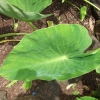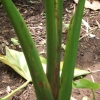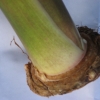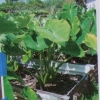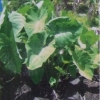Use As Food
Makes poi of good quality.
Distribution
Throughout the islands under both māla (upland) and lo‘i (wetland) cultures. Grown most extensively in Waipio Valley, Hawai‘i, under lo‘i (wetland) culture.
General Characteristics
Medium in height, erect, moderately stocky, maturing in 12 to 15 months, producing from 5 to 10 ‘ohā; distinguished from other Piko by dark green Hā (Petiole) and pinkish kōhina (base).
Ha (Petiole)
65 to 100 cm. long, dark green, usually edged narrowly with dark pink or red, light pink at kōhina (base) with pink ring.
Lau or Lu'au(Leaf Blade)
30 to 45 cm. long, 25 to 35 cm. wide, 20 to 35 cm, from tip to base of sinus (māwae), egg-shaped (ovate), nearly horizontal, chartaceous (paper like), light to dark green; piko whitish; round leaf section (lobes), are split like a "V" to the piko. Shape is obtuse (wide, round) with narrow lihi māwae (sinus).
'I'o kalo (Corm)
Flesh is white with slight pinkish tinge, and it has yellowish fibers. The skin is cream-colored.
Pua (Flower)
Remarks
This is one of the hardiest of the Piko taros, and probably the commonly grown under dryland culture (māla). Piko Uaua and Piko Uliuli are sisters because they both have dark green Hā (Petiole).

